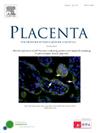正常血压和子痫前期妊娠胎盘滋养细胞对维生素D反应的比较蛋白质组学分析。
IF 2.5
2区 医学
Q2 DEVELOPMENTAL BIOLOGY
引用次数: 0
摘要
背景:维生素D缺乏/不足是子痫前期的危险因素。已知维生素D支持胎盘滋养细胞功能,但滋养细胞对维生素D反应的细胞和分子机制仍不清楚。本研究旨在表征正常胎盘和子痫前期胎盘滋养细胞中维生素D调节的蛋白表达谱、信号通路和细胞网络。研究设计:本研究包括14个胎盘,其中7个来自正常妊娠,7个来自子痫前期病例。分别分离和培养含或不含维生素D的滋养细胞,用Western blot分析维生素D受体的表达。凝胶蛋白组学分析结合液相色谱-串联质谱(LC-MS/MS)分析蛋白表达谱。使用PANTHER数据库进行功能富集和途径分析。结果:正常胎盘和子痫前期胎盘滋养细胞对维生素D有不同的蛋白表达谱和信号通路。在正常滋养细胞中,维生素D上调氨基酸和脂肪酸代谢相关蛋白等。在子痫前期滋养细胞中,维生素D上调与细胞骨架动力学和ATP代谢相关的蛋白质。值得注意的是,维生素D在正常和子痫前期滋养细胞中下调MHC I类受体相关蛋白。结论:维生素D调节滋养层细胞的多种蛋白质表达谱和信号通路,影响关键的生物过程,如能量产生、生物合成、代谢、细胞运动和呼吸。重要的是,维生素D介导的MHC I类受体活性下调表明维生素D在促进母胎界面免疫耐受方面的潜在作用。本文章由计算机程序翻译,如有差异,请以英文原文为准。
Comparative proteomic analysis of placental trophoblasts from normotensive and preeclamptic pregnancies in response to vitamin D
Background
Vitamin D deficiency/insufficiency is a risk factor for preeclampsia. Vitamin D is known to support placental trophoblast function, yet the cellular and molecular mechanisms underlying trophoblast responses to vitamin D remain largely unclear. This study aims to characterize the protein expression profiles, signaling pathways, and cellular networks modulated by vitamin D in trophoblasts derived from normal and preeclamptic placentas.
Study design
Fourteen placentas were included in this study—seven from normal pregnancies and seven from preeclamptic cases. Trophoblasts were isolated and cultured with or without vitamin D. Vitamin D receptor expression was assessed using Western blot analysis. A gel-based proteomic assay combined with liquid chromatography-tandem mass spectrometry (LC-MS/MS) was used to analyze protein expression profiles. Functional enrichment and pathway analysis were performed using the PANTHER database.
Results
Distinct protein expression profiles and signaling pathways were observed between trophoblasts from normal and preeclamptic placentas in response to vitamin D. In normal trophoblast cells, vitamin D upregulated proteins associated with amino acid and fatty acid metabolism, etc. In preeclamptic trophoblasts, vitamin D upregulated proteins related to cytoskeletal dynamics and ATP metabolism. Notably, vitamin D downregulated MHC class I receptor-associated proteins in both normal and preeclamptic trophoblasts.
Conclusion
Vitamin D modulates a wide range of protein expression profiles and signaling pathways in trophoblasts, impacting key biological processes such as energy production, biosynthesis, metabolism, cell motility, and respiration. Importantly, vitamin D-mediated downregulation of MHC class I receptor activity suggests a potential role of vitamin D in promoting immune tolerance at the maternal-fetal interface.
求助全文
通过发布文献求助,成功后即可免费获取论文全文。
去求助
来源期刊

Placenta
医学-发育生物学
CiteScore
6.30
自引率
10.50%
发文量
391
审稿时长
78 days
期刊介绍:
Placenta publishes high-quality original articles and invited topical reviews on all aspects of human and animal placentation, and the interactions between the mother, the placenta and fetal development. Topics covered include evolution, development, genetics and epigenetics, stem cells, metabolism, transport, immunology, pathology, pharmacology, cell and molecular biology, and developmental programming. The Editors welcome studies on implantation and the endometrium, comparative placentation, the uterine and umbilical circulations, the relationship between fetal and placental development, clinical aspects of altered placental development or function, the placental membranes, the influence of paternal factors on placental development or function, and the assessment of biomarkers of placental disorders.
 求助内容:
求助内容: 应助结果提醒方式:
应助结果提醒方式:


